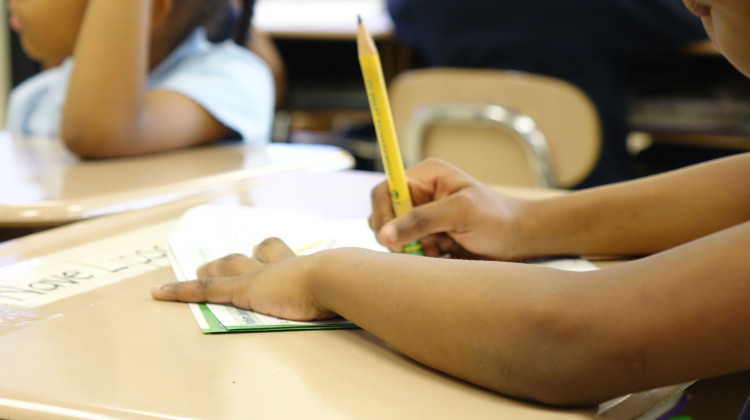
In 2024 nearly seven out of 10 Indiana students are not considered proficient in both the math and English language arts state standards.
Eric Weddle / WFYIIndiana students are still struggling to make up academic ground lost since the COVID-19 pandemic disrupted learning four years ago.
This year nearly seven out of 10 students, or 69.2 percent, are not considered proficient in both the math and English language arts state standards, according to new ILEARN scores released by the state Wednesday.
Only 30.8 percent of students passed both portions of the exam.
This year’s results are mostly the same compared to the last two years. But specific student groups dropped in the assessment’s core subjects while others found gains.
ILEARN is the statewide growth assessment that measures English language arts, science, social studies and mathematics skills for students in grades three through eight.
State education officials said English language arts scores alone from some subgroups of students improved since before the pandemic. Statewide, student scores only edged by a 0.3 percentage point from last year.
Overall, 41% of students were proficient in ELA.
Indiana dropped slightly in mathematics as about 40.7 percent of elementary and middle school students passed the exam, down about a 0.2 percentage point.
The reading skills of third graders is an intense focus for improvement after years of declines. Most educators are required to be trained in new literacy teaching methods to address the problem. This year, 38.6 percent of third graders passed ILEARN’s ELA assessment.
The students most impacted by the pandemic – rising fourth graders – have the lowest proficiency in English language arts among others grade levels. These students began their kindergarten years on a delay, remote or a hybrid curriculum.
"It is essential that our local schools and parents/families continue to work together and stay laser-focused on improving student learning in ELA, as well as math,” said the state’s Secretary of Education Katie Jenner.
In 2021 student scores, and overall academics, plummeted following the closure of schools and widespread remote learning forced by the COVID-19 pandemic.
Students did not take the assessment in 2020. While most Indiana students returned to the classroom by the end of that year, students have struggled to recover academic gains while facing other challenges, such as mental health.
“Our students in grade three have the lowest proficiency in ELA and the greatest proficiency level is at grade eight, but it's reversed in math,” said IDOE Chief Academic Officer Lynn Schemel.
There's little change in the disparity in academic performance between groups of students.
Black students had slight gains in both ELA and math but still hold the lowest performing position compared to Asian, White and all other student groups. Since 2021, Black students have seen a 3.5 percentage point increase in ELA and a 5.4 percentage point increase in math.
State education officials expressed relief to see improvements in reading and English proficiency for English Language Learners. Last year, those students were targeted for additional support.
The number of ELL students is increasing across the state. Roughly 6 percent of Indiana’s student population are English Learners.
Students learning English improved ELA scores by 0.8 percentage points.
“This was a good news element to see a slight bit of recovery,” Jenner said.
However, those students fell significantly in math by about 3 percent. Schemel said ELL students will continue to receive targeted support in the subject.
High schoolers' SAT test
State leaders also shared how high school students performed on the SAT, which fulfills a required college entrance exam set by lawmakers. The assessment includes math, reading and writing sections.
More than 80,000 high school students, primarily juniors, took the test. About 24 percent of students were considered college ready in both math plus reading and writing.
Nearly 52 percent of high school students met the SAT’s reading and writing benchmarks, which is about the same as last year.
State board member B.J. Watts said that number appears skewed since it does not consider students who don’t plan to attend higher education but who are still required to take the exam.
“There's probably some students that are not college bound and may not take this test as seriously as others,” Watts said.
Jenner said there’s a lot of work to do.
State officials said one way they hope to see growth in student achievement is consistent benchmarks from more frequent testing rather than just a one-time assessment.
ILEARN assessments will now be delivered throughout the year via checkpoints.
About 70 percent of Indiana schools opted to participate in the pilot of these assessments during the 2024-25 school year for grades three through eight.
The new system will launch for the 2025-26 school year.
Rachel Fradette is the WFYI Statehouse education reporter. Contact Rachel at rfradette@wfyi.org.
 DONATE
DONATE






 Support WFYI. We can't do it without you.
Support WFYI. We can't do it without you.